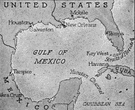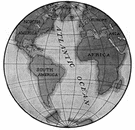
The Names of Bodies of Water
|

|
|
|
Share This Page
|
|
|
|
|
|
|
Follow This Site

|
 |
|
|
|
|

|
Bodies of water have many names. Some mean the same as others, and others are entirely different.
The smallest body of water is the brook, a natural stream of water that is found aboveground and is often called a creek as well. A brook is usually a tributary (a small body of water that naturally flows into a large one) of a river, but this is not always the case. Some people also call these smallest bodies of water streams, although streams can flow underground or even in another body of water (like the Gulf Stream).
Brooks, creeks, streams can be tributaries of rivers. A river is a larger body of water that flows aboveground (or sometimes underground), in a particular direction, and usually has a large volume of water in it. (This varies, of course, according to rainfall and/or snowfall totals. A river will always have more water in it than a stream, however.) Rivers often flow into other bodies of water. For instance, the Mississippi River flows into the Gulf of Mexico.
 A gulf is a large area of a sea or ocean that is partially enclosed by land. Looking at a map of the Gulf of Mexico will help you understand this idea. A gulf is a sheltered area of shoreline into which water flows and gathers. It is the largest kind of body of water with this description. The smallest is a cove. In between is a bay. A gulf is a large area of a sea or ocean that is partially enclosed by land. Looking at a map of the Gulf of Mexico will help you understand this idea. A gulf is a sheltered area of shoreline into which water flows and gathers. It is the largest kind of body of water with this description. The smallest is a cove. In between is a bay.
Rivers also flow into lakes. A lake is a large body of water that is totally surrounded by land. A pond is the same thing, only with less water and a smaller diameter. No standards exist for how big a pond can become before it is officially termed a lake.
A lake or pond can also have a cove in it. A cove is a small sheltered area of shoreline into which water flows and gathers. A cove that is rather large is called a bay.
 Moving up in size, a sea is a large body of water that is surrounded by land or attached to another body of water. The Caspian Sea is one that is surrounded by land. The Mediterranean Sea is one that is attached to another body of water, in this case the Atlantic Ocean. Why are these bodies of waters seas and not oceans? Geographers don't have a really good reason, other than the definition above. Moving up in size, a sea is a large body of water that is surrounded by land or attached to another body of water. The Caspian Sea is one that is surrounded by land. The Mediterranean Sea is one that is attached to another body of water, in this case the Atlantic Ocean. Why are these bodies of waters seas and not oceans? Geographers don't have a really good reason, other than the definition above.
 An ocean, which is the largest body of water on Earth, is generally thought of as having no boundaries. The Atlantic Ocean has Europe and Africa to the east and North American and South America to the west, but the ocean is still considered to have no boundaries because to the north and south is more water. An ocean, which is the largest body of water on Earth, is generally thought of as having no boundaries. The Atlantic Ocean has Europe and Africa to the east and North American and South America to the west, but the ocean is still considered to have no boundaries because to the north and south is more water.
|
|